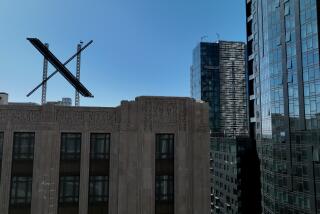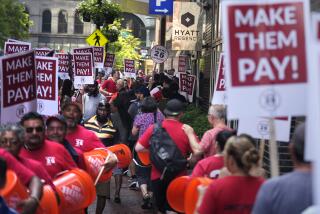Tourism Trouble : This Big Bay Area Industry Is Still Reeling From Octoberâs Quake
SAN FRANCISCO â Until Oct. 17, David Gunter was pulling down $1,400 a month, plus tips, tending bar at the San Franciscan Hotel.
Then came the Bay Area earthquake, which forced the venerable hotel to shut down after chunks of plaster came raining down from the ceiling. Gunter was laid off immediately and doesnât expect to be called back to work until the hotel reopens next month.
âI told my children and my grandkids, âDonât look for anything for Christmas this year,â â said the 62-year-old bartender, who figures he is losing $800 a month despite unemployment insurance. âItâs going to be a bad season for a lot of people.â
Six weeks after the biggest California earthquake since 1906, it is increasingly evident that the 7.1-magnitude temblor did more than cause physical damage, death and injury. The quake also caused severe and ongoing damage to one of the regionâs economic underpinnings, tourism.
Although the San Franciscan is the only major hotel in the city that remains closed, other hotels and businesses that depend on tourism are feeling the pinch as jittery would-be visitors stay away in droves. Hundreds of workers have been laid off and others have had their hours curtailed. With the slow season approaching, tourism officials are hunkering down for a long winter and hoping for a rebound in the spring.
âWith the World Series in town, we went from feast--100% occupancy--to famine,â lamented Suzanne Reese, general manager of the 51-room Wharf Inn. âThese days, weâre lucky to fill 50% of our rooms.â
Retailers and restaurateurs from Chinatown to Fishermanâs Wharf are also singing the blues. âBusiness is bad, very bad, in Chinatown,â said Rose Pak, a consultant to the Chinese Chamber of Commerce, who estimates that firms in the association that cater to tourists have laid off 2,500 workers.
One night this week, Pak said, she âlooked in on 13 restaurants in Chinatown, and nine of them did not have a single table of customers.â
Retailers on Fishermanâs Wharf are equally glum. âItâs dead,â said Myda Mendoza, a cashier at the New World T-shirt shop, surveying the empty store. âIt is always slow this time of year, but this is pathetic,â added Mona Bauer, manager of the Oasis, a womenâs clothing store.
Said Jean Kim, owner of Cable Car Music Box, another store on Fishermanâs Wharf: âWeâve already laid off one person, and weâll be lucky if we can keep paying the rent.â And Ray McCann, a gripman on the Hyde Street cable car line, estimates that ridership remains
30% to 40% of normal as a result of the quake.
Restaurant business picked up somewhat after the Bay Bridge reopened one month after the quake but is still off from last year. âWe were off 26.8% for the month of November, and thatâs continuing into December,â said Andrew Lolli, owner of Castagnolaâs on Fishermanâs Wharf. Lolli has avoided layoffs but is encouraging employees to take vacations and has cut five-day shifts to four.
City officials, keenly aware of the importance of tourist dollars to the local economy, are pulling out all stops to repair the damage. Last month, Mayor Art Agnos visited New York, Chicago and Washington to woo convention planners and spread the word that the city is open for business. Agnos is considering a similar mission to Europe and Asia next year.
The San Francisco Convention and Visitors Bureau dispatched an upbeat âvideo press releaseâ featuring cable cars and scenic vistas to 200 TV stations throughout the country. The bureau also rushed a $300,000 advertising campaign into 15 major newspapers--depleting its advertising budget for next spring.
âFor the first time, we have been forced to sell San Francisco as a destination,â said Charles McElroy, general manager of the Hyatt Regency San Francisco. âOnly then can we turn to selling the hotel.â
McElroy noted that this represents a stunning reversal for a city that before the quake was selected by readers of Conde Nast Traveler magazine as their favorite domestic destination.
âWith all the news about the quake, people around the world had conjured images of a city in rubble when, in fact, only small sections of the city were impacted,â said S. Dale Hess, a vice president of the bureau.
âSome people were worried about aftershocks,â Hess added. âOthers were concerned that they might be putting a burden on the city by coming.â Hess figures the industry is doing 15% to 20% less business than this time last year. Within the industry, convention and business travel is holding up best while leisure travel is down sharply.
Economists say city officialsâ concern is warranted. âIt is difficult to overstate the importance of tourism to San Francisco,â said Joseph Wahed, chief economist for Wells Fargo Bank.
Last year, in addition to their hearts, visitors left $3.4 billion in San Francisco, making the industry the cityâs largest generator of outside cash. About 64,000 people, 65% of them San Francisco residents, were directly employed by the tourist trade. Moreover, the cityâs 11% hotel tax adds millions of dollars to municipal coffers.
In the last 13 days of October alone, San Francisco hotels lost $31.8 million in revenue--$21.8 million from unsold rooms and $10 million from decreased food and beverage sales, according to a survey of the industry by the accounting firm of Pannell Kerr Forster.
Figures for November have not yet been compiled, but some in the industry say that price wars have erupted as hoteliers scrap for whatever business is available. âOur rates are down $10 to $15 a night from last year,â said Reese of the Wharf Inn.
âItâs demoralizingâ she said. âI used to get a Christmas bonus depending on whether the hotel made budget. Well, thatâs gone for this year. Whatâs especially frustrating is that our weather has been beautiful, while all the rest of the country has been having terrible weather.â
Travel industry professionals from outside the region agree that city and industry officials have made all the right moves to restore confidence, but they differ on how long it will take business to return to normal.
âThe city has been doing an incredibly good job of getting the word out to international and domestic tour operators,â said Rebecca Goodell, an official of the Washington-based Travel Industry Assn. of America.
But, said Sid Cass, manager of a Liberty Travel office in New Yorkâs financial district, âPeople donât calculate risks rationally, and right now they are afraid of another earthquake.â
âWho am I to argue when thereâs the whole rest of the world they can visit?â he added. âPeople are buying a vacation, and if thereâs any risk factor at the top of their mind, they cross the place off the list.â
Lee Howard, editor of Airline Economics in Washington, predicted that things should turn around by spring. âTypically, peopleâs memories of disasters are short-lived,â Howard said.
Despite the sharp decline in individual leisure travelers, convention business is holding up well. âSan Francisco is attractive as ever to meeting and convention planners,â said Roy Evans, executive vice president of the Professional Convention Management Assn.
One of the conventions here this week was the American Geophysical Society. âThe earthquake made for an interesting convention,â said Don Siegel, visiting from the University of Syracuse. âA lot of us wouldnât have missed it for the world.â
But conventions account for less than 16% of the visitor count. And even though conventioneers are coming, fewer are bringing their spouses this year. That hurts retailers.
More to Read
Sign up for Essential California
The most important California stories and recommendations in your inbox every morning.
You may occasionally receive promotional content from the Los Angeles Times.










